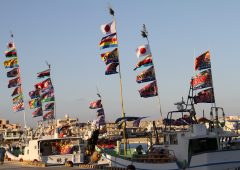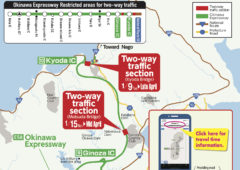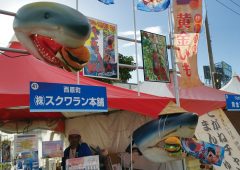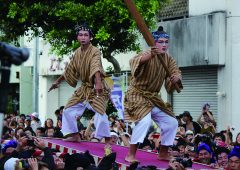2014.07.23
Japan accused of concealing base relocation details

The relocation of MCAS Futenma to Camp Schwab includes plans to construct facilities in the inland area that are not made known to local residents and the Japanese government insist don’t exist.
Heated allegations are flying across Okinawa and new revelations are showing Japan’s been less than forthcoming about the extent of the massive base relocation program in Nago City’s Henoko District that will become home to the controversial Futenma Marine Corps Air Station.
Documents dating to 2008 and 2010 which provide details on expansion of facilities on Camp Schwab in northeastern Okinawa, including building more than two dozen new facilities west of Highway 329 near the Marine base, are now public. They show that the central government has withheld from local lawmakers and the public the extent of the relocation plan.
Futenma will relocate to Camp Schwab, with its new runways extending into Oura Bay adjacent to the base, and that alone has continued to be a source of irritation for base opponents, who wanted Futenma moved from Okinawa and not to another location on the island. The release of the U.S. government briefing documents show plans to significantly expand Camp Schwab to land across Highway 329, to the west. The documents, which were prepared for briefings to key members of the U.S. Congress, identified “political challenges” and concerns that construction in the inland area would stir “sensitivities” the Japanese government would have to contend with.
The 2008 U.S. government internal briefing paper outlined plans for building troop housing, an athletic facility and support buildings for use by Marines –more than 30 facilities in all– at Camp Schwab in an undeveloped forest area to the west of Highway 329. The forest area is already part of the Marines’ Camp Schwab, but the Japanese government has been withholding details of the exact development plans. That portion of the base is now used only for military exercises.
The Japanese government has publicly stated only that the wooded area west of Highway 329 would be the site for extracting soil for use in the land reclamation for the runways and adjacent coastal areas. The documents, which were never intended for public release, had notations by the U.S. authors, that Japanese officials had “hidden from the public” relevant details of the base relocation project. A U.S. government official who refused to be identified acknowledged that the Japanese Defense Ministry was wary about releasing the details to Okinawa. He says U.S. officials remain “baffled” that the Defense Ministry and its subordinate agencies are still denying any plans for expanding Camp Schwab’s facilities into any new areas.
An aside to the Henoko issues was a notation in the 2010 briefing paper regarding the planned introduction of the Marines’ tilt-rotor MV-22 Osprey to Okinawa. The document confirms Japan was fully aware of the U.S. plans, but did not tell anyone. The first public announcement came from the U.S. Department of Defense in June 2011 that the Ospreys would be arriving in Okinawa, to Futenma Marine Corps Air Station, in mid-2012.
Nago City officials say they’re still getting denials from the Defense Ministry’s offices on Okinawa that there are any plans for construction of new facilities in new locations on Camp Schwab. Nago officials say the Okinawa Defense Bureau has denied any such plans in response to their queries. Talking only about plans for using the soil for the reclamation part of the base relocation, it told Nago officials it plans to plant trees on the site once the soil has been removed.

 2024.02.07
2024.02.07 2024.01.31
2024.01.31 2023.12.11
2023.12.11 2023.11.02
2023.11.02 2023.10.26
2023.10.26 2023.09.29
2023.09.29 2023.09.01
2023.09.01 2023.08.22
2023.08.22 2023.08.15
2023.08.15 2023.07.27
2023.07.27






